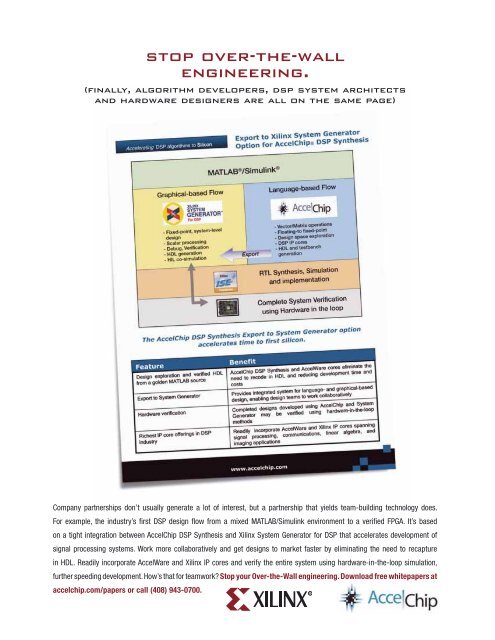Design Challenges: Avoiding the Pitfalls, winning the game - Xilinx
Design Challenges: Avoiding the Pitfalls, winning the game - Xilinx
Design Challenges: Avoiding the Pitfalls, winning the game - Xilinx
You also want an ePaper? Increase the reach of your titles
YUMPU automatically turns print PDFs into web optimized ePapers that Google loves.
DEBUGGING<br />
Using <strong>the</strong> actual constraint of 190 MHz decreased design<br />
performance after implementation from 189 MHz to 180 MHz.<br />
Floorplanner<br />
With <strong>the</strong> help of <strong>Xilinx</strong> Floorplanner, we<br />
can determine <strong>the</strong> connectivity of “s_”. In<br />
Figure 2, “s_” is selected (yellow). The<br />
black lines represent its connectivity in<br />
relation to <strong>the</strong> o<strong>the</strong>r parts of <strong>the</strong> design.<br />
This instance is spread out, so an area<br />
group constraint is necessary. Instead of<br />
entering <strong>the</strong> area group constraint into a<br />
UCF, we entered <strong>the</strong> constraint SCOPE,<br />
which allows <strong>the</strong> Synplify tool to make<br />
timing decisions based off <strong>the</strong> physical<br />
placement of <strong>the</strong> logic. In fact, we achieved<br />
worse results when we entered <strong>the</strong> constraints<br />
directly into a UCF file (bypassing<br />
<strong>the</strong> syn<strong>the</strong>sis tool).<br />
Area Groups<br />
You can enter <strong>the</strong> area group constraint<br />
through SCOPE by selecting <strong>the</strong> attributes<br />
tab. Each cell in SCOPE has a pull-down<br />
menu with only <strong>the</strong> correct values available.<br />
As shown in Figure 3, <strong>the</strong> “s_”<br />
instance is found and <strong>the</strong> xc_area_group<br />
constraint is selected.<br />
After several iterations, we found a good<br />
area group constraint that worked well with<br />
ISE software, producing a minimum period<br />
of 187 MHz. We continued this iterative<br />
process, trying area groups on different<br />
instances as well as trying different PAR cost<br />
tables (a PAR cost table gives a different starting<br />
point for <strong>the</strong> place and route process).<br />
Ultimately, we placed area group constraints<br />
on two instances inside of “s_” and<br />
Figure 3 – Area group constraint<br />
used a PAR cost table setting of 8 to get <strong>the</strong><br />
final minimum period of 189 MHz, close<br />
to <strong>the</strong> arbitrary goal of 190 MHz and a significant<br />
improvement over <strong>the</strong> unconstrained<br />
design speed of 115 MHz.<br />
As a final confession, we used <strong>the</strong> NCF<br />
period constraint of 220 MHz. Using <strong>the</strong><br />
actual constraint of 190 MHz decreased<br />
design performance after implementation<br />
from 189 MHz to 180 MHz. This is<br />
not normal behavior from PAR. Overconstraining<br />
in PAR can have <strong>the</strong> same<br />
detrimental results as over-constraining<br />
in syn<strong>the</strong>sis, so a design with a positive<br />
effect of an over-constrained period in<br />
PAR represents a corner case.<br />
Conclusion<br />
Our design was small and easily fit in <strong>the</strong><br />
smallest Spartan-3 device. However,<br />
using <strong>the</strong> same methodologies outlined in<br />
this article, a significantly larger design<br />
can meet timing using Synplify Pro’s constraints<br />
and switches and passing those<br />
constraints to ISE software.<br />
Using <strong>the</strong> switches in Synplify<br />
Pro software, SCOPE, and <strong>Xilinx</strong><br />
Floorplanner, our design met <strong>the</strong> arbitrary<br />
goal and a significant timing closure<br />
on a Spartan-3 design.<br />
For more information, visit www.<br />
synplicity.com/products/synplifypro/index.htm<br />
l and www.xilinx.com/spartan3.<br />
Get <strong>the</strong> latest Virtex news<br />
delivered to your desktop<br />
Subscribe Now!<br />
www.xilinx.com/virtex4<br />
96 Xcell Journal Third Quarter 2005<br />
R

















